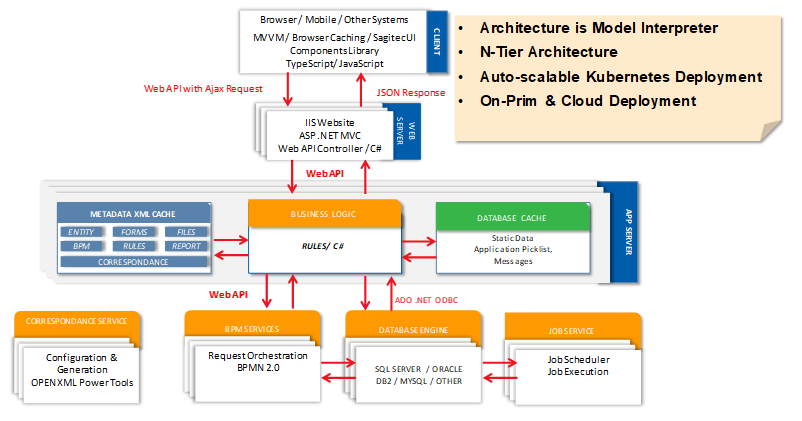Platform Scalability – The Story of Scaling During a Global Pandemic
When the global Coronavirus pandemic hit the U.S. economy in early 2020, the U.S. unemployment rate spiked. New legislation complicated benefits distribution as new systems, new business rules, and new processes were stood up at a moment's notice to deal with the crisis. Of course, one objective for all Sagitec's customers was performance—we needed to serve the hundreds of thousands of people accessing our applications every day.
From an infrastructure perspective, this meant more servers, CPUs, and application servers across the board. The majority of Sagitec's customers began with small footprints and quickly throttled up their infrastructure as the demand was rising. But, to take advantage of everything more infrastructure had to offer, our customers were able to capitalize on Sagitec's architecture to out-scale their peers.
Sagitec's low-code/no-code platform Xelence was architected for scalability—long before the world was facing a global pandemic. Xelence separates the underlying technical architecture from the business architecture, allowing you to evolve layers independently from each other. This separation helps minimize downtime when technology changes, when policies change, or when your environment demands scale.

Sagitec's platform Xelence scaled to meet the high demands of a sudden, large volume of unemployed workforce applying for pandemic benefits. Here are some ways in which we scaled:
The low-code/no-code Xelence platform architecture supports the Command Query Responsibility Segregation design pattern, which allows you to configure a read-only replica of databases.
Embedded in Xelence's architecture is the ability to separate the command queries (i.e., insert and update) from select queries. The primary database is to update records. A secondary database for retrieving records is a read-only replica of the primary database. This configuration provides high availability and disaster recovery features to the enterprise systems. One can offload the read-only and maintenance tasks from primary to the secondary replicas, thereby improving the system's performance.
This allowed us to provide high response times and availability, significantly improving benefits distribution for our customers.
Xelence's architecture supports stateless processes designed to scale on the cloud.
Processing in a distributed system is complex as scalability, reliability, and visibility of these systems matter. Xelence uses Stateless architecture, which doesn't have to allocate and manage resources between requests. If a stateless server fails, another server can easily replace it.
This is important for state workforce agencies who require the bulk of unemployed worker transactions to happen on a specific day of the week. Expensive resources are not sitting idle, and depending on load, new services are scaling up or down based on application usage.
Xelence is cloud platform agnostic and takes advantage of fault tolerance to eliminate downtime, provide the scalability needed, and save costs.
While one can ensure no loss of service for the entire system, we restored a smaller set of services like BPM Engine or Communications Engine to provide scalability and fault tolerance for many customers dealing with the global pandemic.
Xelence is designed for Asynchronous Request-Reply architecture.
In modern application development, it's normal for client applications to depend on remote services to provide business logic and compose functionality. These services may be directly related to the application or be shared services provided by a third party. If these services are called synchronously from the front-end applications, there is an impact on the response latency of business transactions.
By decoupling backend processing services from a front-end host, you can make backend processing asynchronous while the front-end gets a clear response.
Most application development relies on an application developer to manually decide if and how they should handle asynchronous processing. Sagitec's Platform architecture allows developers to choose business transactions for asynchronous processing, thereby reducing the technical complexity of implementing such an asynchronous Request-Reply design pattern.
Xelence provides a robust access control system that helps System Administrators to provide fast and easy access to mass users.
When you set up applications on the Web, it is essential to pay special attention to security aspects when transmitting information between servers and user authentication. It is also crucial to pay attention to access control for activities and shared resources.
Xelence deploys role-based access control. It allows users access to information to perform their duties effectively. The user access policies are defined where user roles and resources are tied. Sagitec's customers made an existing user into a call center agent during the pandemic with a few simple steps. This is possible since dynamic User Access policies enable the access, delegation, revocation, and management of access policies in runtime.
Xelence's Application Performance Monitoring (APM) feature allows Sagitec's customers to proactively identify bottlenecks before end-users face it.
As applications become increasingly complex, finding the root cause of an issue can be a daunting exercise. There's nothing worse than an unknown issue being reported by end-users and then scrambling to figure out what the problem is.
Sagitec's Platform Architecture addresses this challenge by providing a unique set of tools as a service to get a grip on performance from an early stage.
The applications regularly record all levels of logging and store it when an error occurs. APM identifies trends by gathering statistics of application performance. It analyzes the CPU, memory, and individual services, measures queries, and alerts if you exceed a limit. It also recommends improvements.
Sagitec's customers scale functionality by redeveloping shadow applications using Xelence.
Gone are the days that organizations can afford to own, manage, maintain, and support 130+ different software applications. Users have forever expressed frustration with—what feels like—a million separate logins and having to learn a million other solutions.
Now, more than ever, IT shops can provide a single, consolidated solution to their organizations, eliminating redundant data, reducing application maintenance and support costs, and improving user experience—all while aligning IT under a single umbrella.
During this global pandemic, State Workforce Agencies continued to quickly replace and integrate shadow applications with the main application using Sagitec's Platform.
Scalability is a core feature of Xelence, allowing our customers to scale up or down as the circumstances demand. If you would like to know more about Xelence, please click below.
You May Also Like
These Related Stories

How Sagitec Scales to Meet Project Demands

Member Engagement at Scale: Crafting Operational Processes



No Comments Yet
Let us know what you think